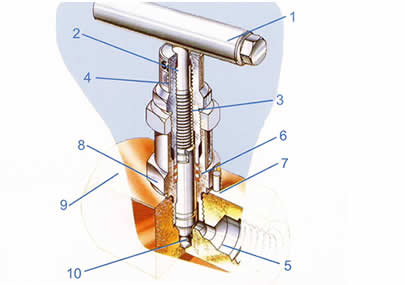- Products
1. Austenitic stainless steel one piece handle
A rugged, corrosion resistant, vibration proof handle which can easily be removed for gland maintenance or panel mounting.
2. Effective Thread Seal (integral with gland follower)
The most effective dust barrier/lubricant containment seal on any instrument valve. Fully integral with gland follower and will not degrade in any service condition as material is compatible, with other valve components (i.e. standard PTFE, graphite in high temperature versions).
3. Unique NIFLOR coated stem threads
Actuating threads are not only rolled for increased strength and form, but also uniquely coated with a nickel based PTFE coating which protects the thread from wear and ‘galling’ and assists lubrication. This is replaced by a dry film graphite based lubricant for high temperature applications. These coatings combined with the specially designed packing bush significantly reduce the actuating torque during both opening and closing cycles. This in turn helps to reduce gland wear.
4. Head Unit service label
The head units are easily identified by means of a service identity label located around the top of the gland follower. These labels give the extreme working conditions for each head unit type combined with colour code to help identify the gland type. These labels are supplemented by head unit function labels on all manifold head units for easy identification. Unlike most instrument valves, this ensures all relevant performance parameters are maintained with the head unit at all times.
5. Pressure tested
Every valve & manifold is pressure tested to BS 6755:Part 1: 1986.
6. Packing Bush
This adjustable bush comprises a specially developed packing sandwich of PTFE/PEEK combined with the non-rotating stem and low actuating torque provides a near maintenance-free life. For high temperature applications a pure graphite bush is provided.

7. Bonnet locking pin
Manufactured in austenitic stainless steel, the bonnet locking pin interferes with the hexagon of the stuffing box to prevent accidental removal of the stuffing box. An optional bracket is available which prevents any attempt to remove the stuffing box from the body.
8. Metal to metal body to bonnet seal (DIN 3852)
A metal to metal body to stuffing box joint complies with the internationally recognised DIN 3852 standard. This ensures a leak proof seal above the maximum test pressures of the valve whilst decreasing the induced stresses so maintaining the safety factor within the valve design. The long engagement length of the stuffing box threads ensures a high joint failure strength verified by independent tests.
9. All wetted parts traceable
All metallic wetted parts in the valves construction are traceable to the original certification. This ensures compliance with the company’s rigid Quality Assurance policy.
10. Hardened Stem for positive shut-off
On metal to metal valves, a hardened stainless steel (17/4PH) spindle (maximum hardness Rc33 to comply with the latest NACE specification) ensures a hardness differential of at least 12 points Rockwell C assuring positive bubble tight shut off on all applications. For applications where extra sealing ability or wear resistance is required, e.g. dirty gaseous service, the standard metal stem is coated with a molyb-denum reinforced PTFE coating. The coating is totally regenerating along the length of the stem cone. This method also ensures a facility to shut the valve off if a process temperature in excess of the seat material is accidentally used. This fail safe facility does not apply to conventional soft seated valves. Also being fully integrated with the valve stem there is no danger of the soft seat being removed accidentally or by back-flow situations.